Crackle or crackling may refer to:
Crackle or crackling may refer to:

Cajun cuisine is a style of cooking developed by the Cajun–Acadians who were deported from Acadia to Louisiana during the 18th century and who incorporated West African, French and Spanish cooking techniques into their original cuisine.
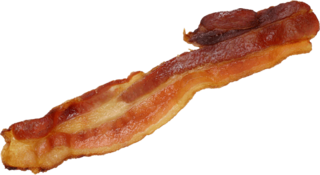
Bacon is a type of salt-cured pork made from various cuts, typically the belly or less fatty parts of the back. It is eaten as a side dish, used as a central ingredient, or as a flavouring or accent.

A sausage is a type of meat product usually made from ground meat—often pork, beef, or poultry—along with salt, spices and other flavourings. Other ingredients, such as grains or breadcrumbs may be included as fillers or extenders.
Rind may refer to:
Crackles are the clicking, rattling, or crackling noises that may be made by one or both lungs of a human with a respiratory disease during inhalation, and occasionally during exhalation. They are usually heard only with a stethoscope. Pulmonary crackles are abnormal breath sounds that were formerly referred to as rales.
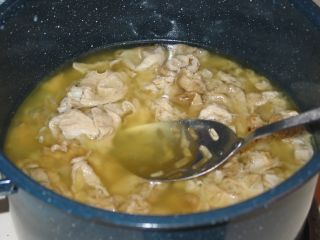
Chitterlings, sometimes spelled chitlins or chittlins, are the small intestines of domestic animals. They are usually made from pigs' intestines. They may also be filled with a forcemeat to make sausage. Intestine from other animals, such as beef, lamb, and goat is also used for making chitterling.
Scratch or scratching may refer to:

Red pudding is a meat dish served mainly at chip shops in some areas of Scotland. Red pudding is associated with the east of Scotland, particularly Fife, but has become less common in recent years. Its main ingredients are beef, pork, pork rind or bacon, suet, rusk, wheat flour, spices, salt, beef fat and colouring.

A fritter is a portion of meat, seafood, fruit, vegetables, or other ingredients which have been battered or breaded, or just a portion of dough without further ingredients, that is deep-fried. Fritters are prepared in both sweet and savory varieties.
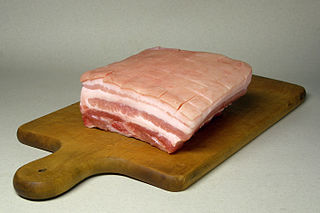
Pork belly or belly pork is a boneless and fatty cut of meat from the belly of a pig. Pork belly is particularly popular in Filipino, Hispanic, Chinese, Danish, Norwegian, Korean, and Thai cuisine.

Chicharrón is a dish generally consisting of fried pork belly or fried pork rinds. Chicharrón may also be made from chicken, mutton or beef.

Pancit, also spelled pansít, is a general term referring to various traditional noodle dishes in Filipino cuisine. There are numerous types of pancit, often named based on the noodles used, method of cooking, place of origin, equal and constant diameter or the ingredients. Most pancit dishes are characteristically served with calamansi, as its freshly-squeezed juice may be used for additional seasoning.

Salo or slanina is an Eastern European food consisting of cured slabs of fatback with or without skin. It is commonly eaten and known under different names across Eastern and Southeastern Europe, and is traditional to multiple national cuisines in the region. It is usually dry salt or brine cured. The East Slavic, Hungarian and Romanian variety is sometimes treated with paprika or other seasonings, while the South and West Slavic version is often smoked.

Bánh xèo is a crispy, stuffed rice pancake popular in Vietnam. The name refers to the sound a thin layer of rice batter makes when it is poured into the hot skillet. It is a savoury fried pancake made of rice flour, water, and turmeric powder. It can also be called a Vietnamese crêpe. Some common stuffings include pork, prawns, diced green onion, mung bean, and bean sprouts. Bánh xèo is often served with sides. Usually, some commonly added ingredients include leafy greens like lettuces or perilla leaves, other herbs as flavor enhancers like mint leaves and Thai basil, cucumbers, and pickled vegetables, usually carrots and radishes. Lastly, its dipping sauce is Nước chấm. Elements of each side and sauce add to the fresh-tasting fried Bánh Xèo.

Mì Quảng, literally "Quảng noodles", is a Vietnamese noodle dish that originated from Quảng Nam Province in central Vietnam. In the region, it is one of the most popular and nationally recognized food items, and served on various occasions such as at family parties, death anniversaries, and Tết.
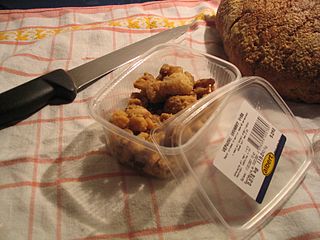
Čvarci is a specialty popular in Southeastern Europe, a variant of pork rinds. They are a kind of pork cracklings, with fat thermally extracted from the lard.
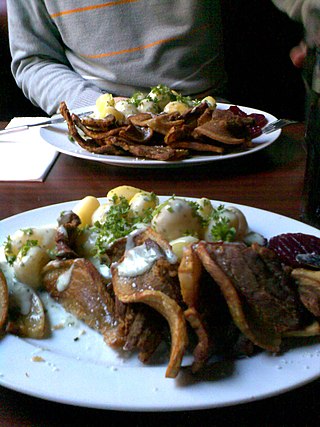
Stegt flæsk is a dish from Denmark consisting of fried pork belly and generally served with potatoes and parsley sauce (persillesovs). The dish is sometimes translated as 'pork strips' or 'crisp fried pork slices'. The pork belly or "breast" cut of a pig is used for stegt flæsk and the strips are cut about 1/4 inch thick.
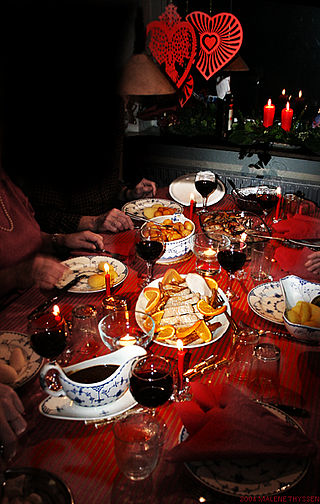
Flæskesteg, the Danish version of roast pork, is considered to be one of Denmark's principal national dishes. Always prepared with crackling, it is also a favourite for the Danish Christmas dinner served as the evening meal on 24 December or Christmas Eve.
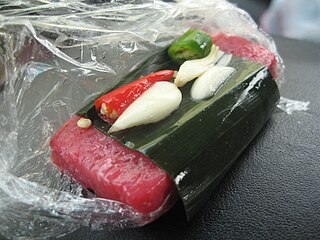
Nem chua is a fermented pork dish from Vietnamese cuisine. It is mainly composed of a mixture of lean pork and thin strips of cooked rind, garnished with garlic and chilli. It can take the form of bite-size pieces wrapped individually in aluminum foil and paper, or a kind of cervelat in sealed plastic. It has a sweet-sour taste characteristic of lactic fermentations, a beautiful pink color and a firm and elastic texture.

Pork rind is the culinary term for the skin of a pig. It can be used in many different ways.